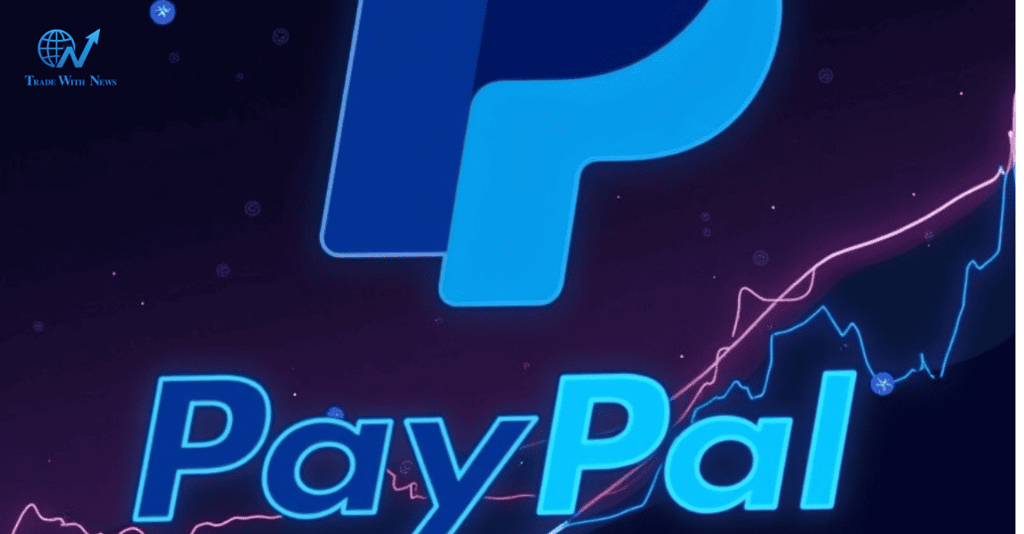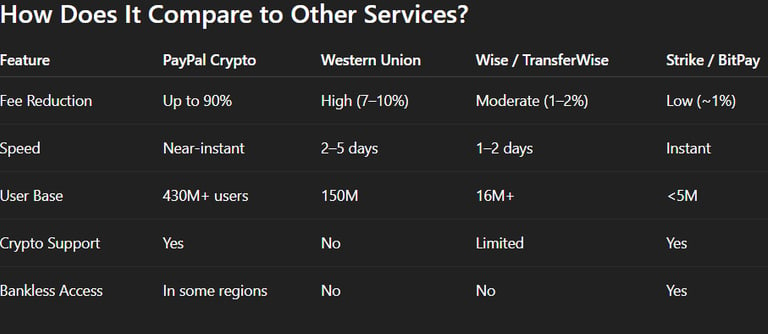PayPal Launches Crypto Payments to Slash Cross-Border Fees by 90%
PayPal unveils crypto payment service to cut cross-border fees by 90%. A major shift for global remittances, merchants, and everyday users. Full story here.
CRYPTO
Ayushi
7/29/2025


Transferring money across borders has always been pricey, sluggish, and riddled with fees. But PayPal is turning it all upside down in a big way now. The fintech giant has finally rolled out a cross-border payment service powered by cryptocurrency that it says will reduce international transfer fees by as much as 90%.
This isn’t just a minor update—it’s a bold move into the future of finance. By combining its massive user base with the speed and efficiency of blockchain, PayPal is signaling that crypto is no longer just for traders—it’s for everyone.
In this blog, we’ll explore:
What PayPal’s crypto payment service is all about
How it works and who it benefits
The potential impact on the global remittance and payment industry
Why it matters for crypto adoption
What it signifies for incumbents such as Western Union, Wise, and traditional banks
What Is PayPal's New Crypto Payment Service?
PayPal's new service enables sending and receiving money across borders with cryptocurrency—namely using stablecoins such as PayPal USD (PYUSD) and other top-tier cryptos such as Bitcoin and Ethereum.
Here's what sets it apart:
90% reduced fees compared to traditional remittance and FX services
Near-instant settlement through blockchain networks
Transparent conversions and live exchange rates
No requirement for the receiver to be a PayPal account holder or have bank access (in chosen regions)
This is not PayPal's initial foray into crypto—it did start trading crypto back in 2020. However, this is the first time it is connecting crypto to real-life applications such as cross-border money transfers and merchant payments.
How Does It Work?
User requests a transfer in fiat (USD) through PayPal app
Money is exchanged to crypto (such as PYUSD or ETH) and transmitted via a blockchain network
Recipient is given crypto or local currency, depending on their location and configurations
Optional: recipient can exchange to fiat or spend directly through PayPal wallet
By eliminating several middlemen—such as correspondent banks, FX providers, and clearing houses—PayPal significantly reduces costs and accelerates the process.
An American user wishes to transfer $100 to a friend in the Philippines. Normally, this would take 3–5 days and $6–$10 in fees.
With PayPal Crypto Payments:
Transfer takes place in minutes
Fees are capped at less than $1
The recipient receives the money directly to their mobile wallet or local bank (where available)
Why This Move Matters
This isn’t just about saving a few bucks on fees. It’s a major milestone for crypto and global payments. Here's why:
✅ 1. Mass Adoption of Crypto Gets a Boost
With over 430 million active PayPal accounts globally, integrating crypto into everyday transactions gives millions of people a practical reason to use crypto, not just trade it.
✅ 2. Remittances Get Revolutionized
Remittance is a $600+ billion global industry. Workers, freelancers, and expats frequently send money home at astronomical costs. PayPal's crypto offering may be a game-changer, particularly in the developing world.
✅ 3. Competing Against Crypto-Native Apps
It's already possible for apps such as Revolut, Strike, and BitPay to provide remittances in crypto, but PayPal's enormous scale and regulatory tie-ups provide it with a gigantic competitive advantage.
✅ 4. New Use Cases for Stablecoins
Stablecoins such as PYUSD are now not only sitting in wallets—they're transferring value across borders, in real-time, for actual people. That's the sort of use case that regulators and companies want to see.
Who Stands to Gain From This?
Regular People
Individuals who send money to relatives overseas can now send money quicker, cheaper, and with less hassle. No more dealing with dodgy money changers or extortionate bank charges.
Contractors and Remote Workers
If you're employed by international customers, getting paid in crypto with low fees can save the day—particularly in nations where PayPal had few withdrawal choices before.
Small Businesses and Merchants
SMEs with international supply chains or customers can make payments to international suppliers using PayPal, receive foreign payments, and pay invoices quicker.
Underbanked Communities
Millions in Africa, Southeast Asia, and Latin America lack bank accounts—yet they possess mobile phones. With crypto rails, they can be paid with no middleman bank.
What About the Risks?
All new technology has trade-offs. As bold as this step is, it's not without its downsides:
⚠️ 1. Regulatory Uncertainty
Crypto regulations differ significantly from country to country. While PayPal has a good compliance team, pushing crypto payments into new territories will involve regulatory certainty and collaborations with local authorities.
⚠️ 2. Volatility
Though stablecoins address some of this, crypto volatility remains a risk. PayPal addresses it by converting fast, but end-users have to know what they're sending or receiving.
⚠️ 3. Security
As usage grows, so do scams and phishing attempts. Education and wallet security are still important.
⚠️ 4. Network Congestion & Fees
PayPal will likely rely on Ethereum and Layer 2s but could still have sudden traffic spikes slow down transactions or increase gas fees.
How Does It Compare to Other Services?
What's in Store for PayPal and Crypto?
PayPal's crypto plans don't stop here. From recent interviews with their executives, the company is:
Experimenting with on-chain merchant payments using crypto
Developing multi-currency stablecoin support
Creating NFT payment integration platforms
Collaborating with blockchain analytics companies for added security
Piloting AI-driven crypto transaction fraud detection
All indications are that PayPal will be a major player in Web3 and fintech innovation, and not just another payments app.
Final Thoughts: The Future Is (Finally) Happening
For years, the crypto space has discussed mass adoption and practical real-world applications. PayPal's new cryptocurrency payment service could be the biggest move towards that in 2025.
By reducing cross-border fees by 90%, eliminating entry barriers, and providing a known platform to the world, PayPal is closing the gap between the old finance world and the future of money.
So next time you're sending money overseas, you might ask yourself:
Are you still losing 10% in fees—or are you ready to go crypto?


About Company


